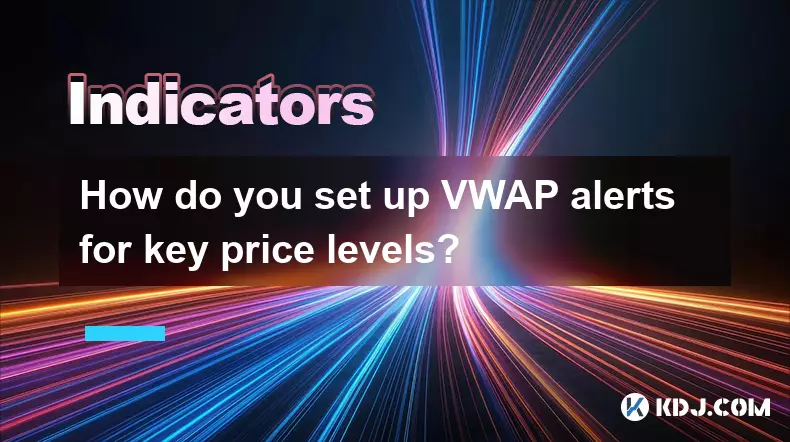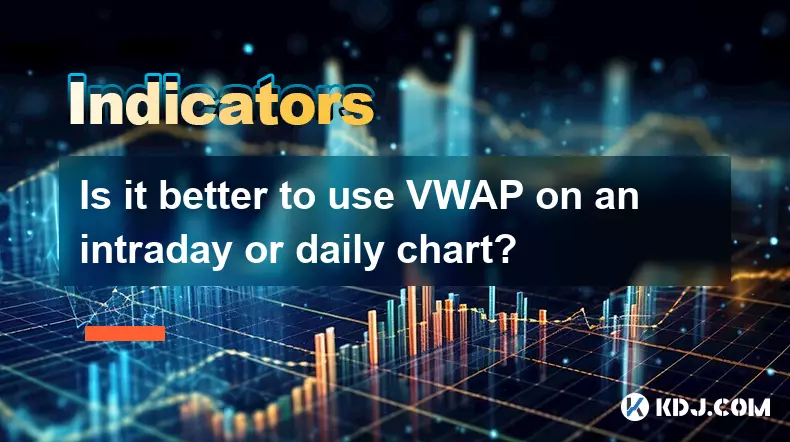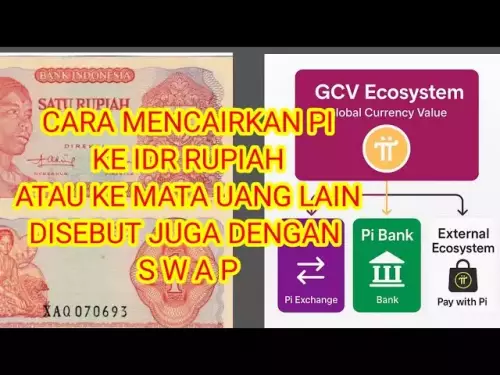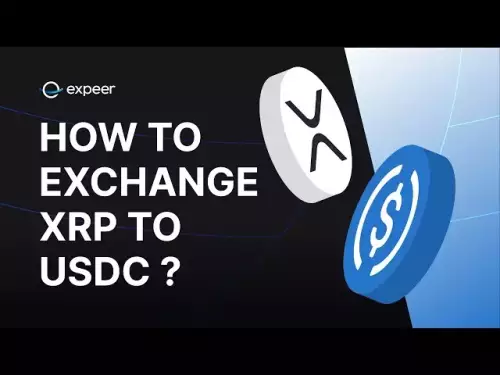-
 bitcoin
bitcoin $112715.707551 USD
-1.71% -
 ethereum
ethereum $4101.475385 USD
-3.01% -
 tether
tether $1.000644 USD
-0.02% -
 bnb
bnb $1207.619465 USD
-6.77% -
 xrp
xrp $2.501451 USD
-3.98% -
 solana
solana $202.947124 USD
-3.32% -
 usd-coin
usd-coin $1.000295 USD
0.04% -
 dogecoin
dogecoin $0.203884 USD
-4.47% -
 tron
tron $0.317154 USD
-1.72% -
 cardano
cardano $0.695009 USD
-4.43% -
 hyperliquid
hyperliquid $38.853961 USD
-8.23% -
 chainlink
chainlink $18.988674 USD
-4.64% -
 ethena-usde
ethena-usde $1.000233 USD
-0.03% -
 stellar
stellar $0.337050 USD
-3.63% -
 bitcoin-cash
bitcoin-cash $536.861728 USD
-1.28%
How do you set up VWAP alerts for key price levels?
VWAP helps crypto traders gauge trend direction and execution quality by weighting price against volume, making it a valuable tool in volatile markets.
Oct 13, 2025 at 12:18 am

Understanding VWAP and Its Role in Crypto Trading
1. The Volume Weighted Average Price (VWAP) is a trading benchmark that represents the average price of an asset based on both volume and price over a specified time period. Traders use it to assess market trends and determine whether they are buying or selling at favorable prices. In the volatile environment of cryptocurrency markets, VWAP provides a dynamic reference point influenced heavily by transaction volume.
2. Unlike simple moving averages, VWAP accounts for how much of an asset was traded at specific price points. This makes it particularly useful for identifying institutional activity, as large orders tend to shift the VWAP significantly. When price is above VWAP, it often signals bullish sentiment; when below, bearish momentum may be building.
3. For crypto traders, integrating VWAP into their analysis helps filter out noise during high-volatility periods. It serves as both a trend confirmation tool and a potential support/resistance level, especially on intraday charts where volume patterns emerge clearly throughout the trading session.
Setting Up VWAP Alerts on Trading Platforms
1. Most advanced trading platforms such as TradingView, Bybit, or Binance allow users to apply VWAP directly onto price charts. To set up alerts, begin by adding the VWAP indicator from the platform’s studies or indicators menu. Once plotted, traders can observe how price interacts with the VWAP line across different timeframes.
2. After applying VWAP, locate the alert creation function—usually represented by a bell icon or “Add Alert” button. Define the condition for the alert, such as “Price crosses above VWAP” or “Price drops below VWAP.” Some platforms also allow deviations from VWAP, enabling alerts when price moves beyond a standard deviation band around VWAP.
3. Customize alert parameters to suit your strategy. For example, you might want notifications only during specific hours or when multiple conditions align, like RSI confirming overbought conditions alongside a rejection at VWAP. Ensure notifications are enabled via email, SMS, or pop-up depending on your preference.
4. Test the alert setup using historical data or paper trading to verify its accuracy. Misconfigured thresholds can lead to false triggers, especially in choppy or low-volume market phases common in altcoin trading.
Using VWAP Alerts for Key Price Level Strategies
1. One effective method involves monitoring retests of VWAP after strong breakout moves. If price pulls back to touch or slightly pierce the VWAP before reversing, it may indicate continuation. A properly timed alert can capture this moment, allowing swift execution without constant screen monitoring.
2. Traders often combine VWAP with anchored versions that start from significant market events—like the opening of a new futures contract or a major news release—to track sentiment shifts more accurately. Anchored VWAP alerts help identify whether momentum is sustained or fading relative to pivotal moments.
3. In ranging markets, VWAP tends to act as a magnet. Price frequently gravitates toward it before reversing near technical boundaries. Setting alerts for convergence between price and VWAP within defined ranges can highlight potential fade opportunities.
4. During high-impact events such as exchange listings or macroeconomic announcements, VWAP behavior changes rapidly. Real-time alerts become crucial for detecting sudden imbalances between buying and selling pressure, offering early signals before broader market recognition.
Optimizing VWAP Alert Sensitivity
1. Overly sensitive alerts generate excessive noise, especially in low-cap cryptocurrencies where price spikes occur frequently. Adjusting the required deviation threshold—such as triggering an alert only when price moves 2% away from VWAP—reduces false positives.
2. Consider filtering alerts by minimum volume thresholds. For instance, require that any cross of VWAP be accompanied by a spike in volume exceeding the 20-period average. This ensures that signals reflect genuine interest rather than random fluctuations.
3. Backtesting alert performance across various market regimes—trending, consolidating, and gap-filled environments—helps refine criteria for live deployment. Historical replay tools available on platforms like TradingView make this process accessible even for retail traders.
4. Avoid relying solely on VWAP crossovers. Combine them with structural elements such as Fibonacci levels, order book depth, or candlestick patterns to increase signal reliability. An alert system gains value not just from speed but from contextual relevance.
Frequently Asked Questions
Can VWAP be used effectively on all cryptocurrency timeframes?Yes, VWAP functions on all timeframes, but its effectiveness varies. On lower timeframes like 5-minute or 15-minute charts, VWAP offers precise intraday insights. On higher timeframes such as daily or weekly, its recalculated nature limits usefulness compared to traditional volume-adjusted metrics.
Why does my VWAP alert trigger too frequently on small-cap coins?Small-cap cryptocurrencies often exhibit erratic volume and price swings. These conditions cause rapid deviations from VWAP, leading to frequent alerts. Implementing volume filters or widening deviation requirements can reduce unnecessary notifications.
Is there a difference between regular VWAP and anchored VWAP in alert systems?Yes. Regular VWAP resets at the start of each trading session, while anchored VWAP begins at a user-defined point. Anchored VWAP is better suited for tracking long-term institutional flows, making its alerts more meaningful during extended trends or accumulation phases.
Do exchanges provide native VWAP alert functionality?Some exchanges like Bybit and Binance offer built-in VWAP indicators with basic alert capabilities. However, third-party tools such as TradingView provide greater flexibility, including multi-condition triggers and custom scripts for sophisticated alert logic.
Disclaimer:info@kdj.com
The information provided is not trading advice. kdj.com does not assume any responsibility for any investments made based on the information provided in this article. Cryptocurrencies are highly volatile and it is highly recommended that you invest with caution after thorough research!
If you believe that the content used on this website infringes your copyright, please contact us immediately (info@kdj.com) and we will delete it promptly.
- Zero Knowledge Proof, Whitelist, Blockchain 2025: The Dawn of Private, Scalable Infrastructure
- 2025-10-16 01:20:01
- Altcoins, Whales, and Tariff Threats: Navigating the Crypto Seas
- 2025-10-16 01:20:01
- ChatGPT's Crystal Ball: HBAR Price Prediction and the Rise of Snorter in 2025
- 2025-10-16 01:20:01
- ZEROBASE Listing and Airdrop: A New Era for ZK Tech?
- 2025-10-16 00:25:13
- Digital Euro, Gold Standard, and Active Reserves: A New York Minute on the Future of Money
- 2025-10-16 00:25:13
- TCG OTS Pack Spoilers: What's Hot and What's Not?
- 2025-10-16 00:33:47
Related knowledge

What's the main difference between VWAP and TWAP?
Oct 12,2025 at 11:54am
Understanding VWAP and Its Role in Crypto Trading1. Volume Weighted Average Price (VWAP) is a trading benchmark that calculates the average price of a...

How do you identify exhaustion moves using VWAP and its bands?
Oct 12,2025 at 08:00am
Understanding the Role of Decentralized Exchanges in Crypto Trading1. Decentralized exchanges (DEXs) operate without a central authority, allowing use...

Is it better to use VWAP on an intraday or daily chart?
Oct 15,2025 at 02:01am
Intraday Trading and the Role of VWAP1. Intraday traders frequently rely on VWAP (Volume Weighted Average Price) as a dynamic benchmark for assessing ...

How do you use VWAP to scale in and out of positions?
Oct 14,2025 at 02:19am
Understanding VWAP as a Dynamic Benchmark1. The Volume Weighted Average Price (VWAP) is not just an indicator—it functions as a dynamic benchmark that...

What are the main advantages of using VWAP over EMA?
Oct 11,2025 at 02:18am
Main Advantages of Using VWAP Over EMA1. Volume-Weighted Average Price (VWAP) incorporates trading volume into its calculation, offering a more accura...

How do you use VWAP on different chart types like Heikin Ashi?
Oct 11,2025 at 05:01pm
Understanding VWAP in the Context of Heikin Ashi Charts1. The Volume Weighted Average Price (VWAP) is a powerful analytical tool commonly used by trad...

What's the main difference between VWAP and TWAP?
Oct 12,2025 at 11:54am
Understanding VWAP and Its Role in Crypto Trading1. Volume Weighted Average Price (VWAP) is a trading benchmark that calculates the average price of a...

How do you identify exhaustion moves using VWAP and its bands?
Oct 12,2025 at 08:00am
Understanding the Role of Decentralized Exchanges in Crypto Trading1. Decentralized exchanges (DEXs) operate without a central authority, allowing use...

Is it better to use VWAP on an intraday or daily chart?
Oct 15,2025 at 02:01am
Intraday Trading and the Role of VWAP1. Intraday traders frequently rely on VWAP (Volume Weighted Average Price) as a dynamic benchmark for assessing ...

How do you use VWAP to scale in and out of positions?
Oct 14,2025 at 02:19am
Understanding VWAP as a Dynamic Benchmark1. The Volume Weighted Average Price (VWAP) is not just an indicator—it functions as a dynamic benchmark that...

What are the main advantages of using VWAP over EMA?
Oct 11,2025 at 02:18am
Main Advantages of Using VWAP Over EMA1. Volume-Weighted Average Price (VWAP) incorporates trading volume into its calculation, offering a more accura...

How do you use VWAP on different chart types like Heikin Ashi?
Oct 11,2025 at 05:01pm
Understanding VWAP in the Context of Heikin Ashi Charts1. The Volume Weighted Average Price (VWAP) is a powerful analytical tool commonly used by trad...
See all articles










































































